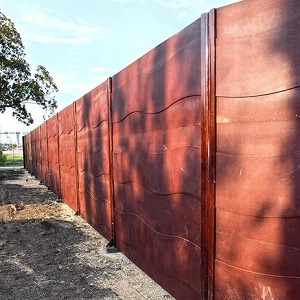 Thursday, September 19, 2024
Thursday, September 19, 2024  Thursday, September 19, 2024
Thursday, September 19, 2024 
Details:
Size: 120″ L x 36″ W / 3.05 m x 0.91 m (Per Unit)
Thickness: 3″ / 0.08 m
Weight: 560 lbs / 254 kg (Per Unit)
Colors: Grey, Black, Redwood, Brown, Terra-Cotta
Applications: Privacy, Sound absorption, Traffic safety
Patterns: Multiple Options
Shipping: 80 Sound Barriers panels per 20′ Overseas Container
Delivery: FOB Legal, Alberta, Canada.
Advantages & Benefits:
Reduces the loudness of traffic noise.
Designed to be visually appealing.
Preserves aesthetic values and scenic vistas.
Can accommodate any two particular design patterns.
Dual formed texture provides higher community acceptance.
Reinforced with a patented rigid spine for added strength.
Easily placed, relocated and removed as needed.
Made of 100% Recycled Rubber tires makes them a durable, long-lasting solution.
Keeping the noise down:
A sound occurs when an ear senses pressure variations or vibrations in the air. The brain relates a subjective element to a sound, and an individual reaction is formed. Numerous studies have indicated that the most pervasive sources of noise in our environment today are those associated with transportation. Highway traffic noise tends to be a dominant noise source in our urban, as well as rural, environment.
What are traffic sound barriers?
Sound barriers are solid obstructions built between the highway and the homes along a highway. They do not completely block all noise they only reduce overall noise levels. Effective noise barriers typically reduce noise levels by 5 to 10 decibels (dB), cutting the loudness of traffic noise by as much as one half. For example, a barrier which achieves a 10-dB reduction can reduce the sound level of a typical tractor-trailer pass-by to that of an automobile.
Barriers can be formed from earth mounds or “berms” along the road, from high, vertical walls, or from a combination of earth berms and walls. Earth berms have a very natural appearance and are usually attractive. They also reduce noise by approximately 3 (dB) more than vertical walls of the same height.
However, earth berms can require a lot of lands to construct, especially if they are very tall.
Walls require less space, but they are usually limited to eight meters (25 feet) in height for structural and aesthetic reasons.
When are sound barriers required?
Sound barriers are not always required at locations where an absolute threshold is met. There is no “number standard” which requires the construction of a sound barrier. Federal requirements for sound barriers may be found in Title 23 of the U.S. Code of Federal Regulations, Part 772, “Procedures for Abatement of Highway Traffic Noise and Construction Noise.” The Federal Highway Administration noise regulations apply only to projects where a State transportation department has requested Federal funding for participation in the improvements. The State transportation department must determine if there will be traffic noise impacts when a project is proposed for (1) the construction of a highway on new location or (2) the reconstruction of an existing highway to either significantly change the horizontal or vertical alignment or increase the number of through-traffic lanes. If the State transportation department identifies potential impacts, it must implement abatement measures, possibly including the construction of noise barriers, where reasonable and feasible. Federal law and Federal Highway Administration regulations do not require State transportation departments to build sound barriers along existing highways where no other highway improvements are planned. They may voluntarily do so, but they are solely responsible for making this decision.
In summary
Most residents near a barrier seem to feel that highway noise barriers effectively reduce traffic noise and that the benefits of barriers far outweigh the disadvantages of barriers. While noise barriers do not eliminate all highway traffic noise, they do reduce it substantially and improve the quality of life for people who live adjacent to busy